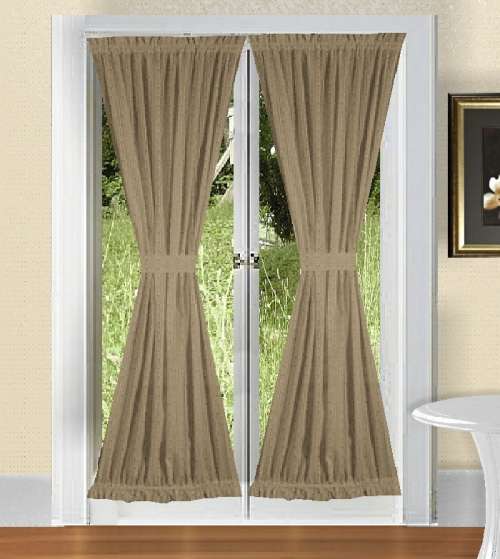French door drapes are not only beautiful but also highly functional in keeping away dust and heat, and adding privacy to a room. Read our guide for more facts and information…
Also known as drapery or drapery panels, drapes are the most popular window treatments for French doors. Though many people assume that drapes and curtains mean one and the same, they are actually different. Drapes are made of heavier lined-fabrics and extend down to the floor unlike curtains which are lighter and shorter. Drapes are invariably pleated, and the pleats come in popular styles such as French and American styles. The following paragraphs describe how drapes can be used to adorn French doors.
Utility Features
French door drapes are excellent for shielding the interiors from dust and strong sunlight. Owing to their better opacity they allow good privacy and are well-suited for closely located homes or apartment balconies. Their thickness completely blocks the view of the interior from the outside. Thermal drapes provide the warmth required in cold regions as they serve as a barrier for the bitter cold that would otherwise enter the home easily. Cotton panel draperies that come with top and bottom rod-pockets are also a nice option for French doors. The floor-length feature and conspicuous pleated design makes them suitable for mansions, banquet halls, and so on, in addition to homes. Drapery rods are equally robust to hold the drapes on hooks, and come with heavy ornate designs to match the interiors. When opened, the hooks easily slide and gather on either end of the rod.
Drapery Fabrics
The color and fabric of drapes are important factors that must be considered before designing French door drapery. The right match can bring a magical transformation to the ambiance. Drape fabrics may be adorned with embroidery, floral prints and geometrical patterns. As drapery is generally pleated and designed to reach the floor, it is important to buy sufficient amount of fabric to meet the requirements. Some of the common drape materials are silk, cotton and thermal fabrics. Silk is much preferred as it is thick, velvety and opaque, making it well-suited to meet the functional and aesthetic requirements.
Drapes Vs Curtains
Curtains are light fabric sheets designed in varying lengths, whereas drapes are heavy fabrics hung with hooks to reach the floor. Sheer and lacy fabrics are common for curtains, unlike drapes that use thicker and opaque fabrics like silk and velvet. Though drapes come with rod pockets as in curtains, pleated models are prevalent. Rings, grommets and tap tops are also some of the drape types. As curtain fabrics are usually unlined, they provide lesser privacy, making them suitable for bigger country homes. Drapes, on the other hand, are fine for closely-built homes as mentioned above. Another important difference is that French drapes are costlier due to the fabric type, and the extra requirement for full-length and pleats also add to the cost. Drapery installation requires expertise, whereas curtains can be installed as a do-it-yourself project.
French door drapes are indeed the best solution for the décor conundrum associated with French doors. Sheer curtain panels combined with overall drapery can give an extraordinary look to the door.





